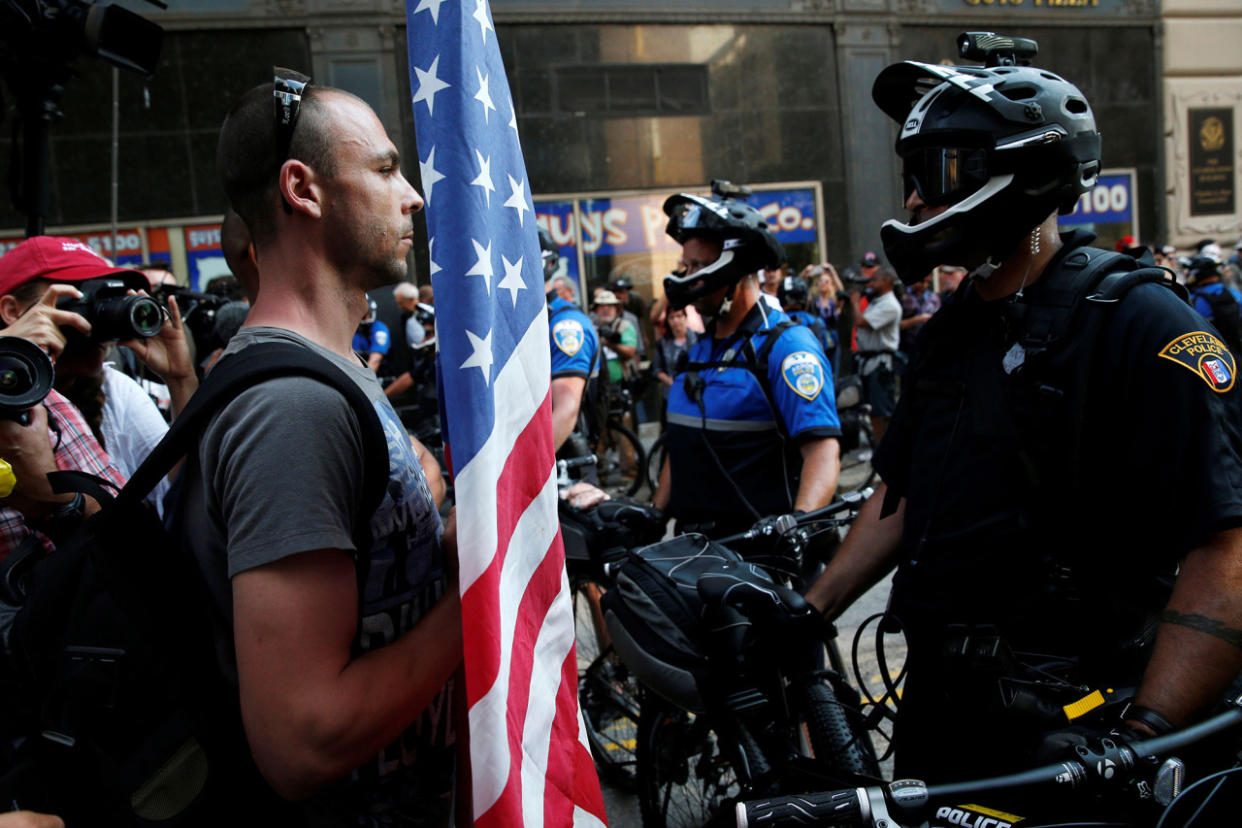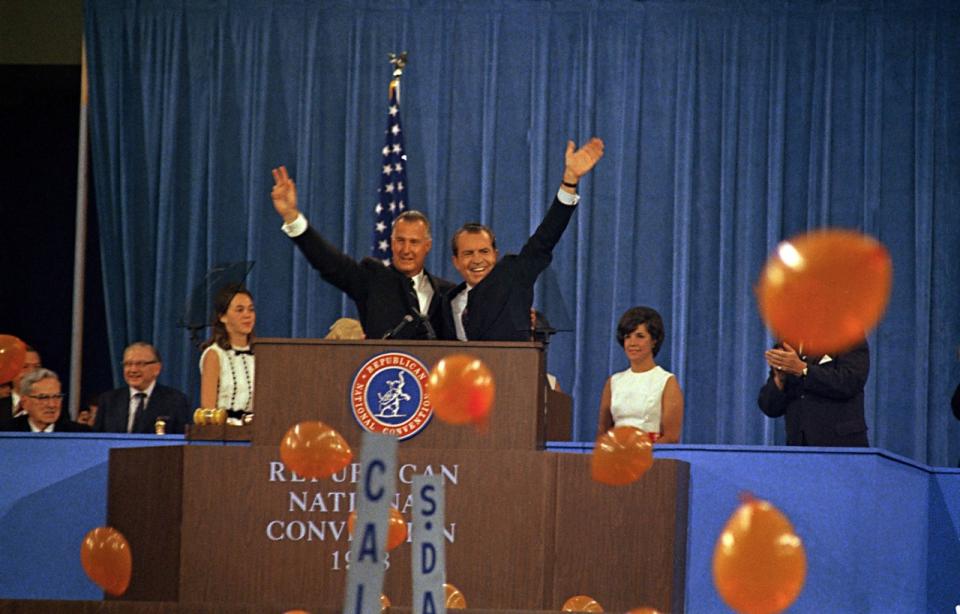Why 2016 isn’t 1968

Protesters are in the streets. Violence — by and against police — is shockingly common, and televised. Chaos is gripping the GOP’s national convention. And Republicans have nominated a chip-on-his-shoulder, knife-fighting white man who promises to uphold law and order and to voice the grievances of the long-suffering “silent majority.”
The surface similarities to the election that brought Richard Nixon to power in 1968 have resonated with commentators and even Donald Trump’s own campaign manager.“If you go back and read” Nixon’s 1968 convention address, Paul Manafort told reporters two days ago, “that speech is pretty much on line with a lot of the issues that are going on today.”
It’s not hard to see why Manafort would be drawn to a historical analogy about a moment of vast division in the United States. In his 1968 speech accepting his party’s nod for president, Nixon painted a picture of a society on the verge of social collapse, a portrait that echoes some of Trump’s own analysis about America’s state of decline. “As we look at America, we see cities enveloped in smoke and flame,” Nixon declared 48 years ago. “We hear sirens in the night. We see Americans dying on distant battlefields abroad. We see Americans hating each other, fighting each other, killing each other at home.”
The media is also abuzz with comparisons of this election season to the political divisions of an earlier ’60s-era civil war. “This Election Is 1968 All Over Again, and That’s Not a Good Thing,” blared one Huffington Post headline. “The 2016 Election Is Looking a Lot Like 1968, for a Lot of Reasons Not So Great,” echoed Forbes.
But as day three of the Republican National Convention begins in Cleveland, let’s put a persistent meme to bed once and for all: 2016 isn’t 1968. The comparisons are overblown, even absurd. Donald Trump is hardly the second coming of Richard Nixon. And the issue of law and order is far from the overriding preoccupation it was 48 years ago. If nothing else, the Republican convention has illustrated why the 1968-all-over-again narrative is so flawed.
In 1968, it’s true, Nixon ran a law-and-order campaign against a Democratic establishment candidate, Hubert Humphrey, and Nixon’s racially coded, populist appeal helped him eke out a victory in November. Still, the gap separating the America of 1968 and 2016 yawns as wide as a chasm. For starters, while crime rates today are “roughly comparable” to what they were in 1968, “the surge [in crime] since 1964 made many Americans more fearful” back then, says historian Michael Flamm, author of the forthcoming “In the Heat of the Summer: The New York Riots of 1964 and the War on Crime.” In recent years, by contrast, street crime rates have been fluctuating — and are sharply down in some cities, including New York — but there has been nothing like the unprecedented spike that sowed mass fear in the 1960s.
As for social unrest, the relatively calm streets of Cleveland during this week’s GOP convention demonstrate that it is at a level far below 1968’s. Following riots in Harlem (1964), Watts (1965) and Detroit (1967), the 1968 riots rocked virtually every major American city. Scores died. Entire neighborhoods burned. There is nothing like that going on in either Cleveland, Philadelphia, Dallas, or Baton Rouge, La., today.
The overall fear of political violence isn’t equivalent, either. In 1968, civil rights leader Martin Luther King Jr. was assassinated by a white supremacist. Democratic presidential candidate Robert F. Kennedy was gunned down by a Palestinian militant, five years after Lee Harvey Oswald murdered President John Kennedy. In 1968, with the draft underway, hundreds of thousands of antiwar demonstrators were marching in the streets and jeering at the White House. Chicago’s police rioted at the Democratic convention, beating young protesters with batons. That kind of bloodshed and social turmoil is unthinkable to Americans watching the relatively calm Cleveland proceedings.
And in spite of his apparent efforts to don Nixon’s mantle, Trump should not actually be seen as Nixon 2.0. Nixon was a far more capable and accomplished politician. By 1968, Nixon had established his bona fides as one of his party’s leading anticommunists, with a reputation for foreign policy know-how, and had spent more than two decades in Washington as a congressman, senator and vice president. Nixon’s racial appeals, though vicious, were often more coded than Trump’s blatant, public nativism and anti-Muslim sentiments.

“Trump is no second coming of Nixon, who was … a far more astute politician with a much more professional campaign staff,” argues Flamm, who also authored a book about the politics of law and order in the 1960s.
The country has moved beyond the social divisions of 1968. The Stonewall riots, which touched off the gay-rights movement, were still a year away, and it was just one year earlier that the Supreme Court had struck down a Virginia law that had banned interracial marriage. Today, same-sex marriage is the law in all 50 states, and the nation’s first African-American president is nearing the end of his second White House term — signs of expanding notions of social equality that were hard for the vast majority of Americans to imagine 48 years ago.
Finally, the economic conditions of 2016 are vastly different than those that helped to fuel Nixon’s ascent. Today’s economic climate — defined by modest job growth, income inequality and a decades-long decline in manufacturing — is nothing like that of 1968. White voters incensed at the stalemate in the Vietnam War, civil rights, urban riots, street protests and the counterculture fueled Nixon’s election victory. Trump’s rise has been propelled by white voters motivated by a different set of hot-button issues: unchecked immigration, terrorism, economic stagnation, an ever more racially and ethnically diverse society, and a government in a state of seemingly constant partisan paralysis.
While the analogy — Nixon won, after all — may offer hope to Trump’s team, the America of 1968 was fractured in ways that make today’s divisions look comparatively mild. In Cleveland tonight, in contrast to the media and political hype, that truth will be hard to miss.
Matthew Dallek, an associate professor at George Washington University’s Graduate School of Political Management, is author of “Defenseless Under the Night: The Roosevelt Years and the Origins of Homeland Security.”
_____
Related slideshows:
On the ground at the RNC Convention – A photo report >>>
Demonstrators protest outside the RNC >>>
Front pages cover Donald Trump’s final primary victory >>>
Melania Trump in the convention spotlight >>>
Convention floor erupts when no roll call taken to change rules to unbind delegates >>>
How newspapers covered the RNC’s fiery first day >>>

